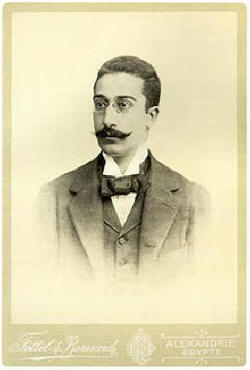

Queer Places:
rue Lepsius, Alexandria, Egypt
15 Queensborough Terrace, Bayswater, London W2, UK
Greek Orthodox Cemetery, Suez Canal Rd, Al Azaritah WA Ash Shatebi, Qesm Bab Sharqi, Alexandria Governorate, Egitto
 Constantine Peter Cavafy (April 29 (April 17, OS), 1863 – April 29, 1933)
was an Egyptian Greek poet, journalist and civil servant.[3]
His consciously individual style earned him a place among the most important
figures not only in Greek poetry, but in Western poetry as well.[4]
Constantine Peter Cavafy (April 29 (April 17, OS), 1863 – April 29, 1933)
was an Egyptian Greek poet, journalist and civil servant.[3]
His consciously individual style earned him a place among the most important
figures not only in Greek poetry, but in Western poetry as well.[4]
Cavafy wrote 154 poems, while dozens more remained incomplete or in sketch form. During his lifetime, he consistently refused to formally publish his work and preferred to share it through local newspapers and magazines, or even print it out himself and give it away to anyone interested. His most important poems were written after his fortieth birthday, and officially published two years after his death.
Cavafy was born in 1863 in Alexandria, Egypt, to Greek parents, and was baptized into the Greek Orthodox Church. His father's name was Πέτρος Ἰωάννης, Petros Ioannēs —hence the Petrou patronymic (GEN) in his name— and his mother's Charicleia (Greek: Χαρίκλεια; née Γεωργάκη Φωτιάδη, Georgakē Photiadē). His father was a prosperous importer-exporter who had lived in England in earlier years and acquired British nationality. After his father died in 1870, Cavafy and his family settled for a while in Liverpool. In 1876, his family faced financial problems due to the Long Depression of 1873, so, by 1877, they had to move back to Alexandria.
In 1882, disturbances in Alexandria caused the family to move again, though temporarily, to Constantinople. This was the year when a revolt broke out in Alexandria against the Anglo-French control of Egypt, thus precipitating the 1882 Anglo-Egyptian War. Alexandria was bombarded by a British fleet, and the family apartment at Ramleh was burned.
In 1885, Cavafy returned to Alexandria, where he lived for the rest of his life. His first work was as a journalist; then he took a position with the British-run Egyptian Ministry of Public Works for thirty years. (Egypt was a British protectorate until 1926.) He published his poetry from 1891 to 1904 in the form of broadsheets, and only for his close friends. Any acclaim he was to receive came mainly from within the Greek community of Alexandria. Eventually, in 1903, he was introduced to mainland-Greek literary circles through a favourable review by Xenopoulos. He received little recognition because his style differed markedly from the then-mainstream Greek poetry. It was only twenty years later, after the Greek defeat in the Greco-Turkish War (1919-1922), that a new generation of almost nihilist poets (e.g. Karyotakis) would find inspiration in Cavafy's work.
In Alexandria in 1924, Socrates Lagoudakis launched a series of attacks not only on the poetry of Constantine Cavafy but also on his character, calling him ‘another Oscar Wilde’. Cavafy’s friends were so shocked that they took to heckling Lagoudakis’ lectures.
A biographical note written by Cavafy reads as follows:
He died of cancer of the larynx on April 29, 1933, his 70th birthday. Among the speakers at his funeral was his friend Gaston Zananiri. Since his death, Cavafy's reputation has grown. His poetry is taught in school in Greece and Cyprus, and in universities around the world.
E. M. Forster knew him personally and wrote a memoir of him, contained in his book Alexandria. Forster, Arnold J. Toynbee, and T. S. Eliot were among the earliest promoters of Cavafy in the English-speaking world before the Second World War. In 1966, David Hockney made a series of prints to illustrate a selection of Cavafy's poems, including In the dull village.
My published books: